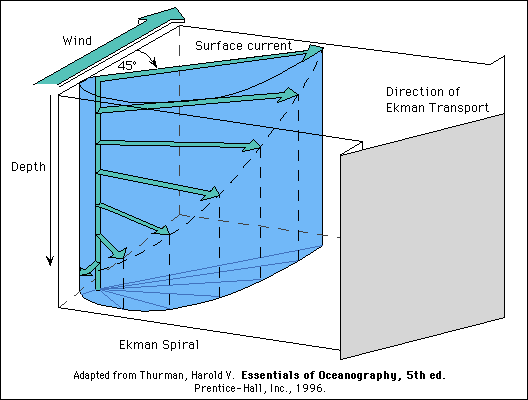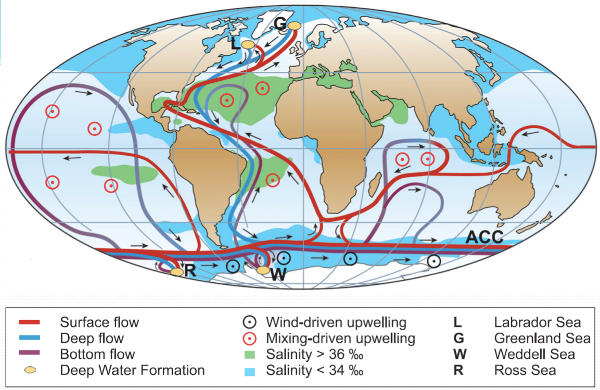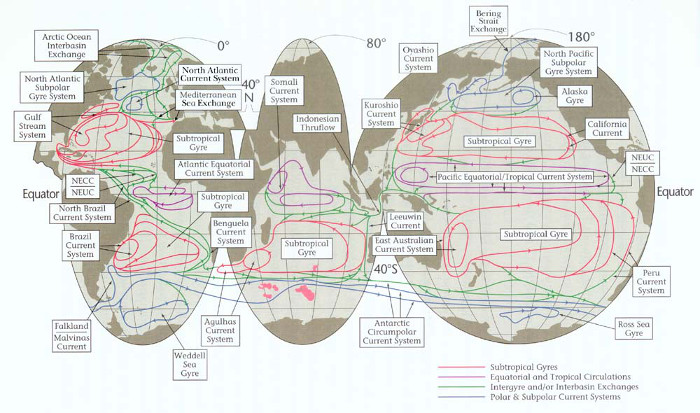Table of Contents
The Conveyorbelt
Author: Seraina Klaus
Thermohaline Circulation
The oceans are mostly composed of warm salty water near the surface over cold, less salty water in the ocean depths. These two regions don't mix except in certain special areas. The ocean currents, the movement of the ocean in the surface layer, are driven mostly by the wind. In certain areas near the polar oceans, the colder surface water also gets saltier due to evaporation or sea ice formation. In these regions, the surface water becomes dense enough to sink to the ocean depths. This pumping of surface water into the deep ocean forces the deep water to move horizontally until it can find an area on the world where it can rise back to the surface and close the current loop (Figure 1).
Figure 1: Schematic representation of the global thermohaline circulation. Surface currents are shown in red, deep waters in light blue and bottom waters in dark blue. The main deep water formation sites are shown in orange. Kuhlbrodt et al 2006.
This usually occurs in the equatorial ocean, mostly in the Pacific and Indian Oceans. This very large, slow current is called «The Thermohaline Circulation» (THC) because it is caused by temperature and salinity (haline) variations. Other names for this current are «Meridional Overturning Circulation» or «The Ocean Conveyor Belt». The gulf stream is a part of the THC in the Atlantic Ocean.
Overview of the Thermohaline Circulation
3niR_-Kv4SM Video: NASA
This animation from NASA shows one of the major regions where this pumping occurs, the North Atlantic Ocean around Greenland, Iceland, and the North Sea. The surface ocean current brings new water to this region from the South Atlantic via the Gulf Stream and the water returns to the South Atlantic via the North Atlantic Deep Water current. The continual influx of warm water into the North Atlantic polar ocean keeps the regions around Iceland and southern Greenland mostly free of sea ice year round.
The animation also shows another feature of the global ocean circulation: the Antarctic Circumpolar Current. The region around latitude 60 south is the the only part of the Earth where the ocean can flow all the way around the world with no land in the way. As a result, both the surface and deep waters flow from west to east around Antarctica. This circumpolar motion links the world's oceans and allows the deep water circulation from the Atlantic to rise in the Indian and Pacific Oceans and the surface circulation to close with the northward flow in the Atlantic.
The color on the world's ocean's at the beginning of this animation represents surface water density, with dark regions being most dense and light regions being least dense.
Driving Forces
Two forces drive ocean circulation:
- Wind stress on the surface
- Buoyancy (heat and freshwater) flux between ocean and atmosphere
Wind-driven Circulation
The upper ocean circulation or surface circulation is a wind-driven circulation. Their patterns are determined by wind direction, Coriolis forces from the Earth’s rotation, and the position of landforms that interact with the currents. This circulation takes place in the mixed layer, on scales ranging from the local to the global, and consists of both horizontal as well as vertical components. Further this includes the gyres. Those are large-scale rotating circulation structures. For example there are five subtropical gyres. (Figure 2) The upper Ocean Circulation ist relatively fast with a velocity of 1-2 m/s.
Figure 2: Gyres in the global ocean. The subtropical gyres are assigned in red.
Ekman Transport
 The wind stress acting on the surface layer of the ocean induces movement of that water. This is called Ekman Layer transport, which extends to the surface 50 to 100 meters («Ekman Layer»). The frictionally-forced flows become weaker and weaker with depth. The Ekman transport is directed at 90° to the direction of the wind, to the right of the wind in the northern hemisphere, left of the wind in the southern hemisphere.(Figure 3) As the wind varies from place to place, Ekman transport can produce divergence (upwelling) or convergence (sinking) of surface water.
The wind stress acting on the surface layer of the ocean induces movement of that water. This is called Ekman Layer transport, which extends to the surface 50 to 100 meters («Ekman Layer»). The frictionally-forced flows become weaker and weaker with depth. The Ekman transport is directed at 90° to the direction of the wind, to the right of the wind in the northern hemisphere, left of the wind in the southern hemisphere.(Figure 3) As the wind varies from place to place, Ekman transport can produce divergence (upwelling) or convergence (sinking) of surface water.
Figure 3: Ekman transport
Geostrophic Currents
Ekman transport causes surface waters to move toward the central region of a gyre from all side and produces a broad mountain of water. The surface waters begins flowing downhill from high pressure to low pressure. Horizontal movement of surface water arising from a balance between pressure gradient force and the Coriolis force is known as a geostrophic flow.
Density-driven Circulation
The deep circulation is driven by large-scale density gradients (in example: buoyancy driven). This gradients are depend of the distribution of temperature and salinity and so the circulation is called thermohaline circulation. The deep Circulation is relatively slow with a velocity of a few meters per day. (See also in the Video from NASA «Thermohaline Circulation»)
Ocean Circulation and Global Climate
The ocean is a major driver of global climate. It redistributes large amounts of heat around the planet via global ocean currents – through regional scale upwelling and downwelling, and via thermohaline circulation. Marine and coastal ecosystems have adapted over time to the ocean circulation patterns as we know them today. Global climate change alters environmental forcing mechanisms – or factors that impact ocean circulation – such as wind, precipitation, temperature, and salinity patterns. These changes in forcing mechanisms may lead to a change in ocean circulation, as well as an increase in storm activity.
Thermohaline circulation behaves like a conveyor belt. In polar latitudes, heat is transferred to the atmosphere, causing the water to become cold and dense and thus renewing the conveyor cycle. Melting of polar ice could reduce the salinity and thus density of polar waters, which could weaken the rate at which this water sinks. Such melting would thus alter movement of heat around the globe.
Atmospheric pressure systems create strong winds along the eastern Pacific. These northwesterly winds lead to upwelling along the western coast of North America. Upwelling, where cold, nutrient-rich waters are brought to the surface, can drive ocean productivity, supporting most productive fisheries worldwide. Such wind patterns are expected to change considerably due to global climate change. Changes in global air temperatures over land and the ocean, as well as increased temperature variation, will alter atmospheric pressure gradients that drive the strength of winds over the ocean. Stronger winds induce a rapid, intense upwelling that provides a large influx of nutrients in a short amount of time. This influx can increase the frequency and distribution of hypoxic events (low oxygen zones). Increased variability of winds due to the changing global climate is also expected to cause stronger and longer El Nino-Southern Oscillation regimes, which are periods of time when the waters in the tropical Pacific are warmer (or cooler) than usual, causing weather and climate consequences throughout the globe. Such increases in adverse ocean conditions may not be tolerable for many marine animals and for humans in this affected regions.
Historical Perspective
Heinrich Event
Heinrich events, first described by marine geologist Hartmut Heinrich, occurred during the last glacial period, or “ice age”. During such events, armadas of icebergs broke off from glaciers and traversed the North Atlantic. The icebergs contained rock mass eroded by the glaciers, and as they melted, this matter was dropped onto the sea floor as “ice rafted debris”. The icebergs' melting caused prodigious amounts of fresh water to be added to the North Atlantic. Such inputs of cold, fresh water may well have altered the density-driven thermohaline circulation patterns of the ocean, and often coincide with indications of global climate fluctuations.
References
Dr. Gian-Kasper Plattner. Introduction to Physical Oceanography. Lesson 12.3.2014.
Columbia.edu, online on: http://eesc.columbia.edu/courses/ees/climate/lectures/o_circ.html, letzter Zugriff: 25.3.2014
Centerforoceansolution.org, online on: http://centerforoceansolutions.org/climate/impacts/ocean-circulation/, letzter Zugriff: 25.3.2014
Svs.gsfc.nasa.gov, online on: http://svs.gsfc.nasa.gov/vis/a000000/a003600/a003658/, letzter Zugriff: 25.3.2014
Earth.yale.edu, online on: http://earth.geology.yale.edu/~avf5/teaching/ResourcesGG535/Lecture20.THC.Florian.pdf, letzter Zugriff: 25.3.2014
Wikipedia.com, online on: http://en.wikipedia.org/wiki/Heinrich_event, letzter Zugriff: 25.3.2014
Comments
- Please revise following points: — Samuel Eberenz 2015/03/10 12:47
- restructure: put the part “Ocean circulation and global climate” in the beginning of the article. (As a starter)
- briefly discuss the different perspectives on the same currents (e.g. Gulf Stream) offered by looking at (a) wind-driven circulation and (b) density driven circulation.
- amend information on the density driven circulation, link to Deep Water Formation and The Conveyorbelt.
- on the wind-driven circulation: put in context to and link to articles on Ekman Transport and Sverdrup Relation.
- Link “Heinrich Event” to the related article-to-be.

